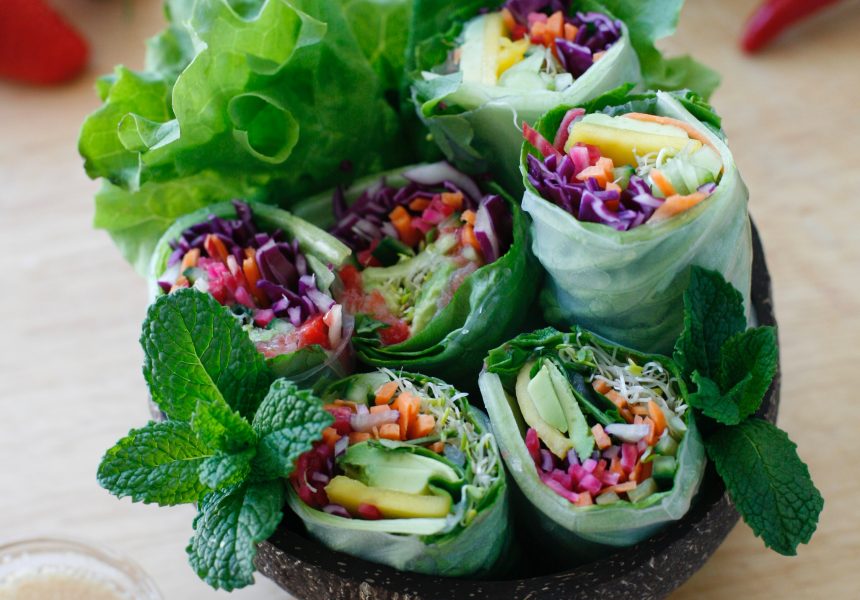This rhubarb shrub makes a really nice and simple spring cocktail when you mix it with ice, gin, and soda water. I recommend adding a sprig of thyme for extra spring freshness. Rather than talk your ear off about it, I’ll just leave the recipe here, encourage you to give it a try, and walk back to my Saturday afternoon gin drink in the yard…..
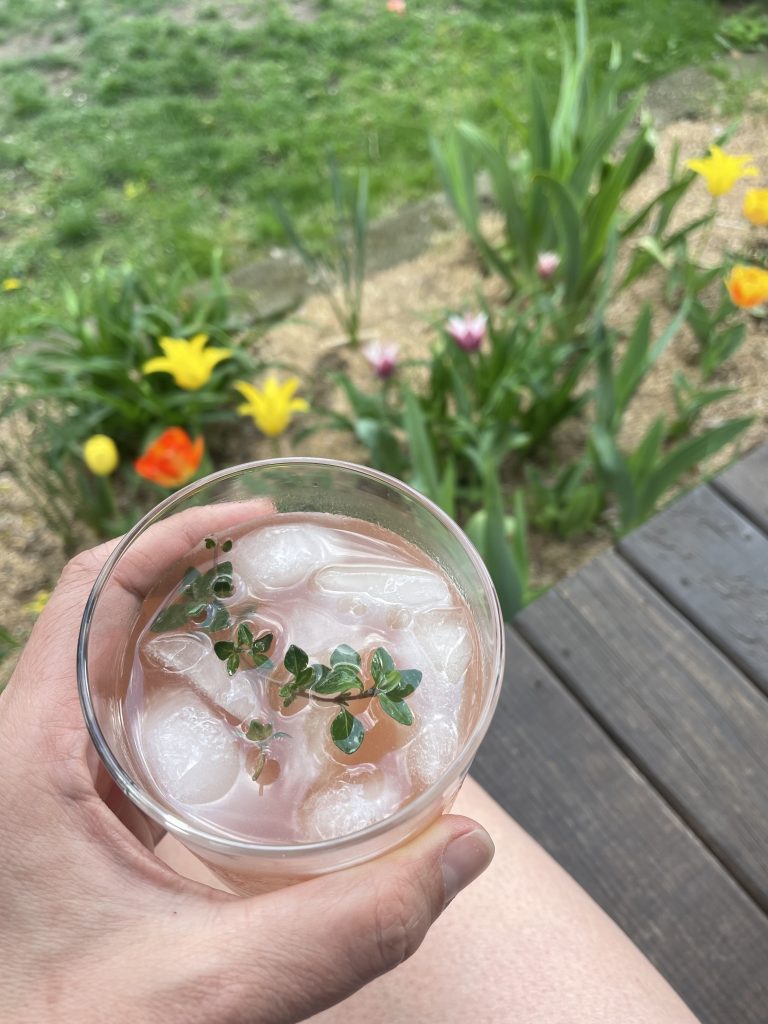
Rhubarb Shrub
Makes about 2 cups
Ingredients
1 pound rhubarb (about 4-6 stalks), roughly chopped
1 cup sugar (maple sugar or 1/2 cup maple syrup work great too)
1 cup water
1 cup apple cider vinegar (I hear red wine vinegar or balsamic are good too, but I haven’t tried them)
Instructions
- Bring rhubarb, sugar and water to a boil in small saucepan. Reduce heat to low and simmer 20 minutes.
- Take off the heat and add the apple cider vinegar. Let cool.
- Strain through a fine mesh sieve (you could use a cheese cloth or clean towel if you need a finer mesh)
- Chill and Enjoy!
This should last just fine in the fridge for a month or so, but I dare you to resist drinking it for that long! I like to add a tablespoon or two to each drink, but you might like more or less.
]]>(Note: this post was originally published in February 2022, but I’ve given it a bit of a refresh for this years Super Bowl game and party)
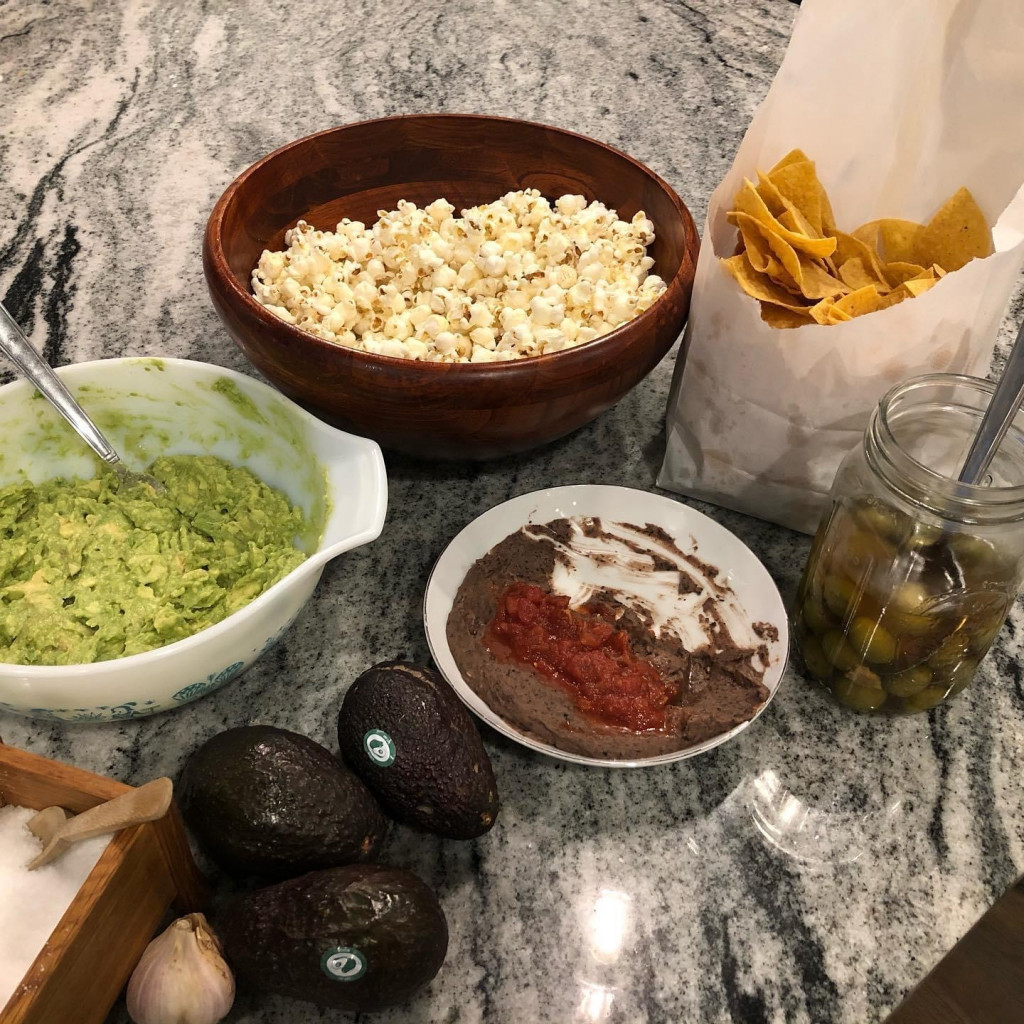
In general, here are my strategies for picking the best (and lowest waste) super bowl (or, erm…. Saturday afternoon or Friday night movie night) snacks:
- Choose homemade snacks – homemade is almost always going to be lower waste than the pre-made alternative (in fact, if you can think of a single example that breaks this rule, tell me in the comments and I’ll figure out some sort of prize!). Think about a bag of potatoes vs frozen tater tots, potato skins or French fries and “naked” avocados, garlic and tomatoes vs the plastic tub of remade guacamole
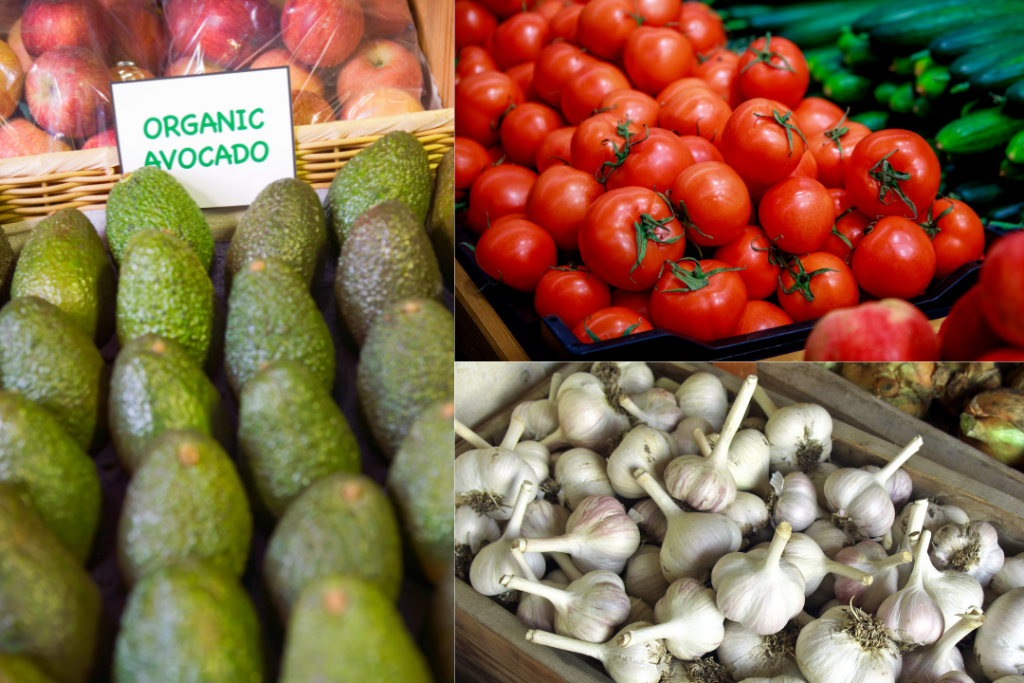
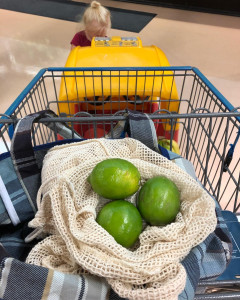
- Look for “naked” ingredients – meaning those you can buy without any packaging. Vegetables and fruits are perfect examples of this. Look for them in bulk bins and DON’T use the plastic bag. You can either bring your own produce bag (see my recommendations here if you want to purchase a few) or just throw them into your cart without a bag… trust me, the cashier will be able to ring them up for you like this just fine!
- Buy local – this is a great opportunity to support your favorite bakery, local farmer, cheese shop, or neighborhood restaurant. Lots of times, businesses like this would be happy to cater your party, make a cheese tray (hint, hint, the Rockford Cheese Shop) or create a large quantity order, but you’d better call ahead… the sooner the better!

 Buy in recyclable packaging – remember that metal and glass can be recycled endlessly (meaning over and over and over and over and… you get the idea), paper 5-7 times, and plastic only 2-3 times. I use this order to guide my packaging selection when I have choices.
Buy in recyclable packaging – remember that metal and glass can be recycled endlessly (meaning over and over and over and over and… you get the idea), paper 5-7 times, and plastic only 2-3 times. I use this order to guide my packaging selection when I have choices.
- Buy in bulk – More food in the same container slightly reduces the packaging:food ratio. This is my last ditch effort to make a more sustainable choice, but this ONLY WORKS if you EAT ALL THE FOOD! Buying more than you eat (to save on packaging) and then throwing away the excess food COMPLETELY defeats the purpose!
OK, on to our favorite snacks! Here they are, in no particular order…
- Guacamole (my favorite) – we’ve already talked about buying the

avocados, garlic, and tomatoes “naked” from the grocery store. Bonus points if you’ve grown any of these ingredients yourself. I go the extra mile and walk to the little Mexican restaurant down the road from my house and buy fresh tortilla chips in a paper bag… they’re SO delicious!
- Kale Chips (my oldest daughter’s favorite) – we’re still getting kale from our winter CSA farm share, so February is the perfect time for kale chips! We use this recipe. Even if you can’t buy it from a local farmer right now, kale is one of those vegetables you can usually find “naked” in the grocery store.

- Popcorn (Robbie’s favorite) – this simple snack is our go to for almost any lazy time around the house. Friday night movie night… is better with popcorn! Thursday night dinner when everyone is too exhausted to cook (or eat a real meal)… popcorn! I make it on the stove and don’t follow a recipe, but this one is pretty close to my routine if you’ve never cooked popcorn before. We buy our popcorn kernels in bulk (25 pound paper bag), but you can usually find kernels in glass jars in the grocery store. I use coconut oil, again purchased in a glass jar, and season with sea salt.
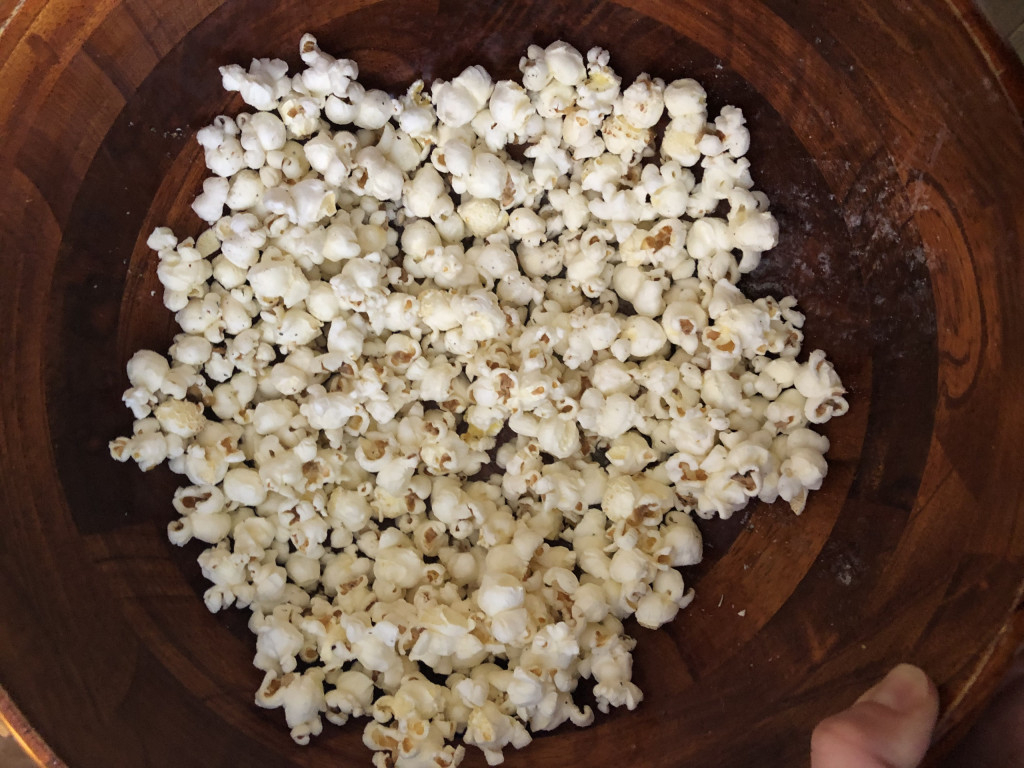
- Bean Dip (my youngest daughter’s favorite) – we nearly always have a batch of cooked black beans in our house (my favorite recipe is from Smitten Kitchen, in her first cookbook The Smitten Kitchen Cookbook, but you can also find the recipe online here) so we can easily whip up a dip with beans + cheddar cheese + sour cream + salsa. I can’t tell you the exact amounts of the ingredients, in part because Robbie always makes this dip and in part because he doesn’t measure, so you’ll have to experiment to find your favorite combo. Again, we eat this with chips from our favorite local restaurant. We buy the beans in bulk (25 pound paper bag) and have a bunch of frozen homemade garden salsa from last summer (but you could buy this in glass), but the cheese and sour cream usually come in plastic.
- 2024 UPDATE: “WEIRD FRUIT” – what?!? what is weird fruit, Erin? This has become the most asked for football snack from both my kiddos. They love to go to the grocery store with me and pick out the most weird looking fruits they can find. Dragon fruit, Buddha’s hand, star fruit… that’s pretty much all we can get at our small town grocery store, but they LOVE this tradition, cutting up and arranging these fruits alongside the more traditional favorites (like cherries, blueberries, and strawberries) for a creative (and lower waste) fruit plate.
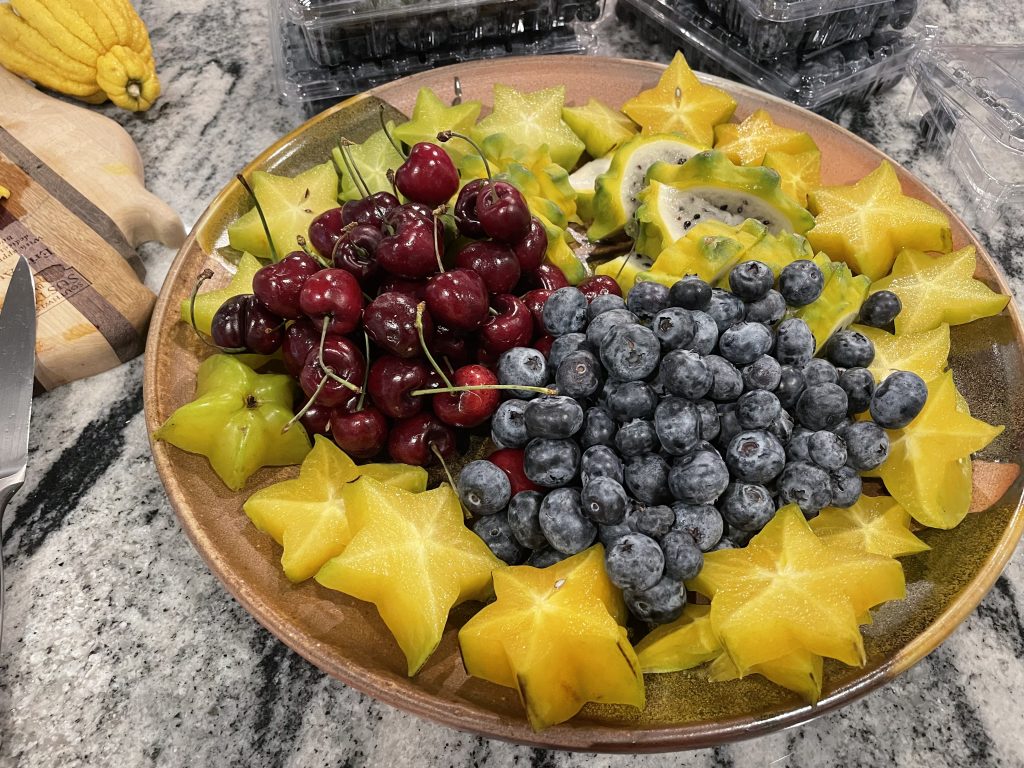
Please add your favorite waste-free, low waste, local or sustainable snack suggestions in the comments!!
]]>There’s a “usual suspects” list of must-see Chicago attractions that get thrown around quite a bit. Whether it’s the Bean, Wrigley Field, Navy Pier, or any number of obligatory things to do while you’re in the Windy City. Your mileage might vary on these endeavors, but Chicago is also becoming a destination for travelers who want to “live like a local.” The stellar food, nightlife, and music scenes are becoming major draws of Chicago. One thing that doesn’t get talked about enough is Chicago as an eco-friendly travel destination.
While it may resemble a concrete jungle as much as any urban metropolis, Chicago has made significant strides in recent years toward becoming an eco-friendly city. City officials have been prioritizing sustainability and environmental initiatives for decades, and you’ll find that an eco-friendly trip to Chicago is very doable.
The biggest thing that Chicago has going for it is its extensive public transportation network. The famous “L” train system serves most parts of the city, and bus routes cover almost the entire city. If the weather is great (big if), Chicago is also very bike-friendly. Chicago’s restaurant scene has fully embraced vegan food and sustainability efforts, so it’s easy to find a plant-based meal in just about every neighborhood. There are also plenty of environmentally-conscious activities and attractions to visit during your trip.
One of the best ways to reduce carbon emissions is to get around on foot or on a bike. If you’ll be propelling yourself around the city, you won’t want to have to lug your bags around all day. Luckily, it’s easy to find convenient luggage storage in Chicago, where you can drop the bags off while you explore the best of the Windy City’s eco-friendly offerings.

Best ways to get around Chicago
While Chicago is a fairly drivable city compared to New York or Los Angeles, there are plenty of sustainable ways to navigate the city. Here are a few:
Public transportation
Chicago has one of the most extensive public transportation systems in the country. Operated by the Chicago Transit Authority (CTA), there are train lines and bus routes that cover almost the entire city’s geographical footprint.
Most of the popular tourist and business districts are directly served by the “L” train system, which is all routed through “the loop” downtown. CTA bus routes cover the rest of the city and are a very affordable way to get around.
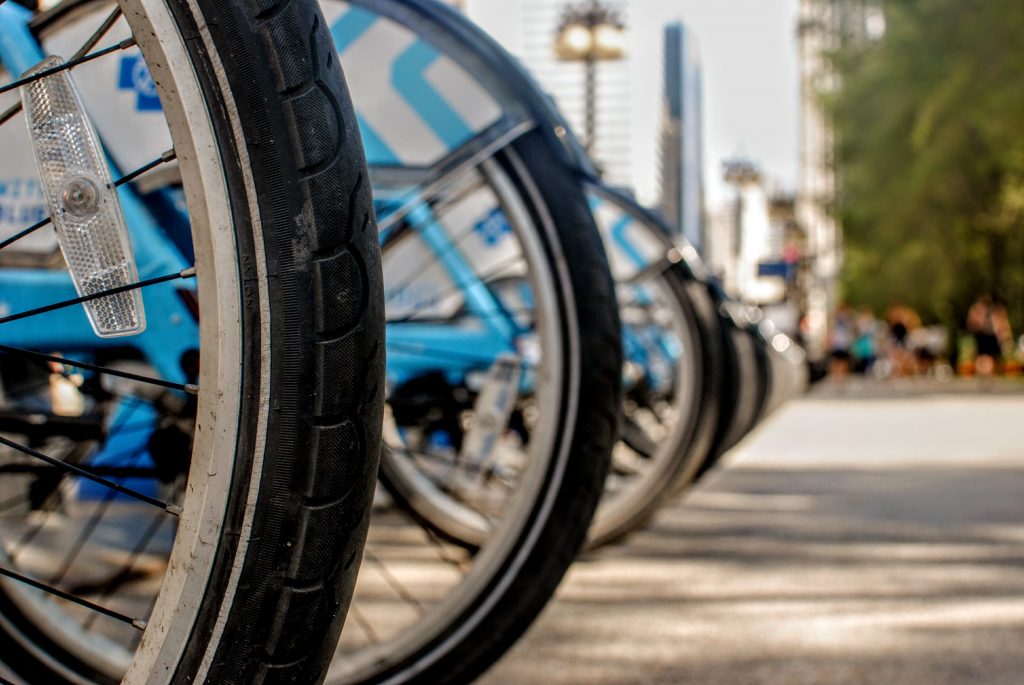
Cycling
Chicago is (almost to a fault) very flat, making it an easy city to navigate on two wheels. In recent years, Chicago has developed a robust cycling infrastructure of designated bike lanes and trails throughout the city.
Divvy, Chicago’s bike-sharing program, is an extremely popular method of transport. During the summer, you can’t miss the thousands of blue bikes being pedaled all over town. This is a great way to get around quickly and conveniently while limiting emissions.
Walking
Chicago’s neighborhoods are pedestrian-friendly and easy to navigate, and it’s generally the quickest way to get around buzzy tourist hotspots and popular nightlife destinations. Depending on your itinerary, you should be able to take the train or a bus to most places and cover the rest of your trip on foot.
Electric scooters
Electric scooters have become VERY popular in Chicago as an eco-friendly mode of transportation. Lime is the most popular service where you can rent an e-scooter to get to and from popular brunch spots and explore neighborhoods.
Vegan restaurants and bars
The windy city may be primarily associated with hot dogs and herculean portions of pizza, but Chicago has a solid vegan restaurant scene. Eating an entirely plant-based diet is one of the best ways to reduce your carbon footprint and minimize animal cruelty. Here are a few notable options for eating vegan while you’re in town:
The Chicago Diner
A beloved institution, The Chicago Diner has been serving up vegan versions of diner classics since 1983. From classic burgers (that you can’t tell are vegan) to hearty brunch scrambles, this menu offers familiar favorites without the guilt.
Handlebar
This laid-back hipster hangout in Wicker Park offers an extensive menu of vegan comfort food. Their seitan wings and vegan mac ‘n’ cheese are both famous among locals, and this cozy spot is an awesome place to have a few drinks as well. During the summer, their back patio is one of the hottest tables in town.
Demera Ethiopian Restaurant
While not exclusively vegan, Uptown’s Demera offers a wide range of vegan-friendly options that showcase the incredible flavors of Ethiopian cuisine. This authentic neighborhood spot features lentil stews, vegetable curries, and injera (fermented flatbread), all of which fit into a plant-based diet.
Bad Hunter
Located in the incredibly lively West Loop neighborhood, Bad Hunter has a vegetable-based menu of inventive modern dishes. The menu isn’t entirely vegan, but there are plenty of options, and they’re known for delicious craft cocktails and natural wine.
Sustainable activities in Chicago
With a stunning lakefront and plenty of parks, there are plenty of ec-friendly things to do during your trip to Chicago. You just have to know where to look!
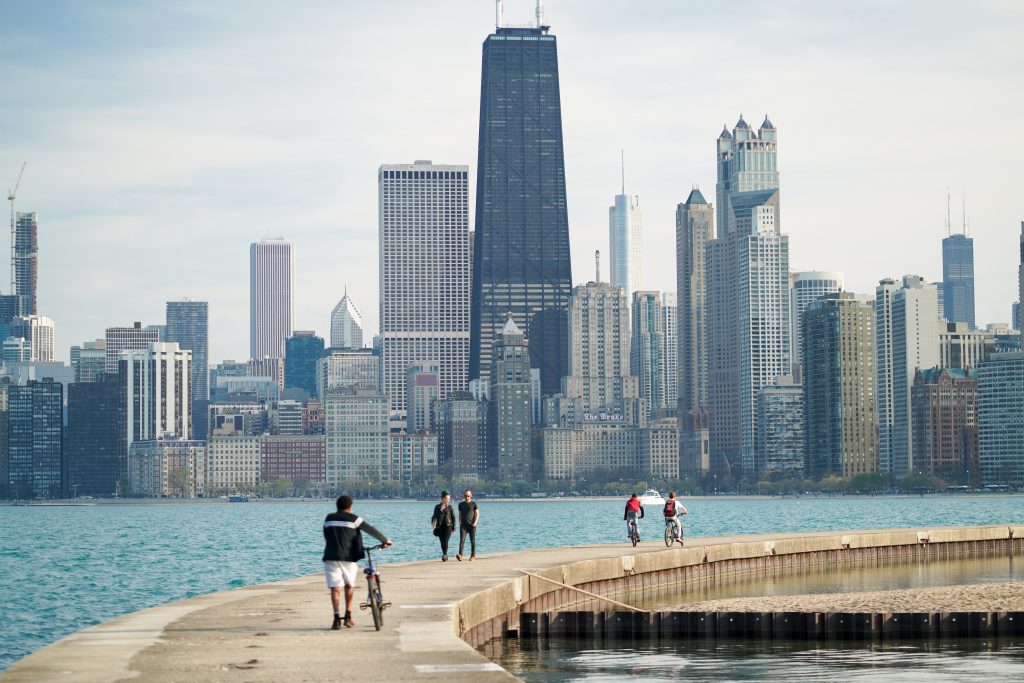
Explore the city by bike
Chicago’s incredible lakefront trail offers amazing views of the skyline along with beautiful Lake Michigan. If you want to see the whole lakefront, you can pedal your way up and down in less than an hour. There is also the 606 trail that runs through uber-trendy neighborhoods like Wicker Park and Logan Square.
Garfield Park Conservatory
Located on the city’s West Side, the Garfield Park Conservatory is one of the most underrated attractions in the city. The Conservatory’s greenhouses are filled to the brim with lush greenery and exotic plants from around the world. There are various themed gardens and a serene atmosphere to enjoy. During the winter, the humid greenhouses will bring you back to life!

Take a kayak tour instead of a boat tour
The Chicago Architecture Tour is one of the obligatory tourist attractions that come highly recommended. While it’s a solid activity, a greener option would be renting a kayak and exploring the Chicago River without a carbon footprint.
Support local farmers’ markets
Many of Chicago’s neighborhoods host a farmers’ market on weekends. If you want to stock up on local goods and buy supplies for a picnic, head to popular pop-ups like the Green City Market or Logan Square Farmers Market. Even if you don’t buy anything, the people-watching is too good to pass up.
This post was written in collaboration with Bounce luggage storage.
Like this content? Want to see more guest posts? Please drop a note in the comments to recommend new topics or contributors we should be collaborating with.
]]>As you know, I’m currently obsessed with sugar snap peas. They’re coming out of my backyard vegetable garden by the pound right now… we’re picking every other day and getting a pound each time! So I’ve had a lot of peas to experiment with. My other favorite recipe is this sugar snap peas salad.
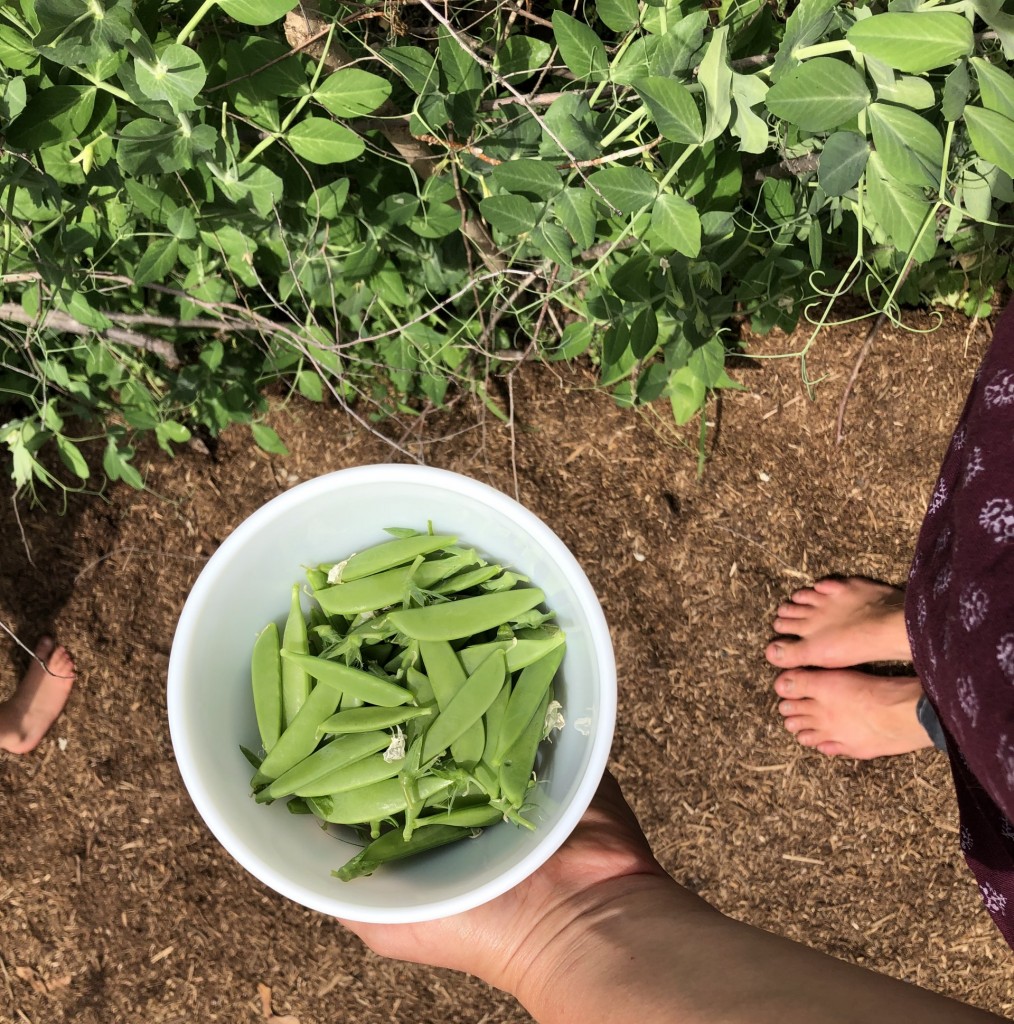
This is our second favorite recipe so far. I love it for two reasons:
- I love any recipe that incorporates my homemade yogurt, especially if its a savory recipe that lets me eat yogurt for dinner!
- Similarly, I love to put delicious toppings on garlic toast! The simplicity of a fancy open face sandwich really makes me happy.
Dilly Beans and Sugar Snap Peas on Toast
adapted slightly from Bon Appetit
Ingredients
1½ cups plain, whole-milk yogurt, drained*
1 teaspoon salt
1 lemon, juice and zest
2 Tablespoons apple cider vinegar
2 teaspoons Dijon mustard
1 teaspoon black pepper
1/4 cup olive oil, plus more for toast
4 chives
8 oz. sugar snap peas
1/2 cup dill
1 14.5-oz can cannellini (3/4 cup dried beans)*
4 slices crusty bread
1 garlic clove
Assembly
- Preheat oven to 400F
- Using a fine mesh sieve, drain your yogurt. Once it’s drained, pour it into a bowl, add lemon zest, and stir to combine.
- In a large bowl, whisk lemon juice, vinegar, Dijon mustard, 1 teaspoon salt, and ¾ teaspoon pepper.
- Whisking constantly, slowly stream in ¼ cup olive oil until dressing thickens slightly and no longer looks oily. You want to add the oil gradually so that your mixture will be creamy and emulsified.
- Trim chives and slice thinly crosswise. Add to bowl with dressing and stir to combine.
- Trim ends of peas and cut on a diagonal into ½” pieces (about the size of your beans) and add to bowl.
- Finely chop dill and add to bowl.
- Drain and rinse beans, then add to bowl with dressing.
- Toss until well coated. Taste and adjust seasoning, adding more salt if needed.
- Place bread on a baking sheet, drizzle (both sides) with olive oil. Toast bread in the oven, finishing on broil if needed to make them extra crispy.
- Rub both sides of the bread with garlic clove; season with a little salt.
- Divide yogurt mixture among toasts. Spoon peas and beans over. Don’t leave any vinaigrette behind: Divide any leftovers among toasts.
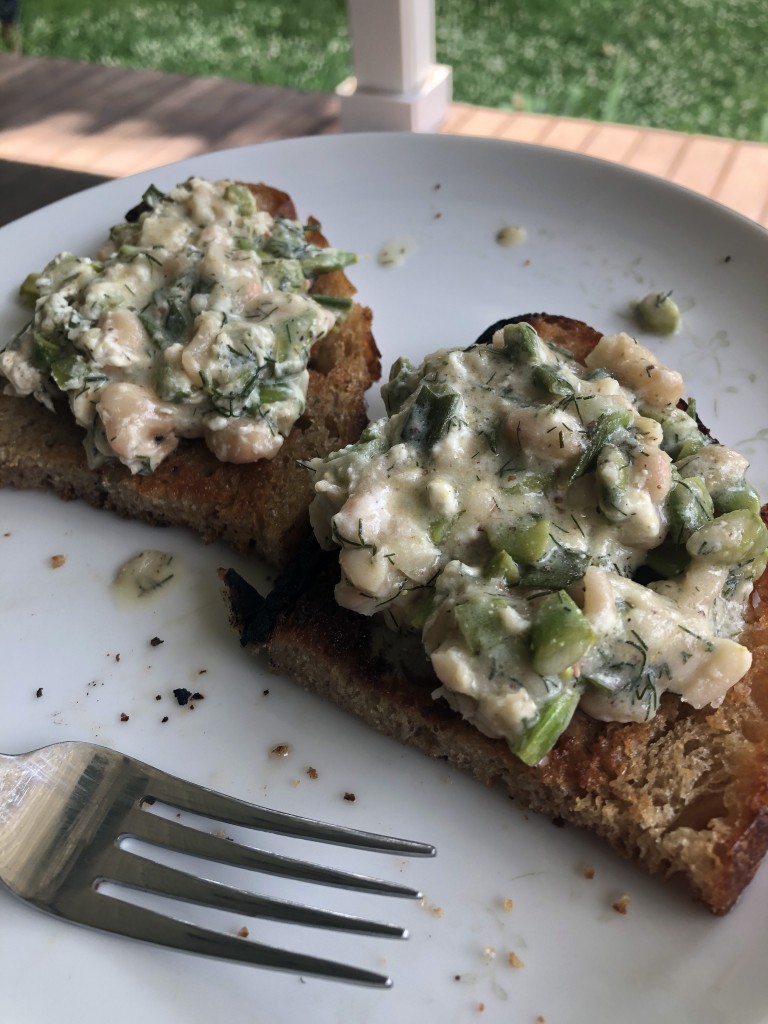
I’m still on the lookout for great pea recipes, so please tell me how you’re using them and send me your favorite recipes in the comments below!
*Recipe Notes:
- You could use greek yogurt or ricotta instead of draining whole-milk yogurt. The original recipe calls for ricotta, which I never have in my fridge. On the other hand, I make my own yogurt every single week, so I’ve always got plain, whole-milk yogurt.
- I almost always cook dried beans in my instant pot. If you’re like me, you’ll need to cook 3/4 cup dried beans for 40 minutes in the instant pot.
I hear you… “ok, Erin, but after I’ve roasted and frozen them, what do I DO with all these beautiful red peppers?”
Let me introduce you to my FAVORITE fall soup: Roasted Red Pepper Curry Soup. It’s easy to make, gluten free, dairy free, and EVERYONE in my family is happy to eat this meal! This recipe works well with roasted red peppers from a jar if you’re short on time or you could follow steps 1 and 2 below with just 3 or 4 peppers if you want to make a batch of soup today (and skip the freezing all the peppers step).
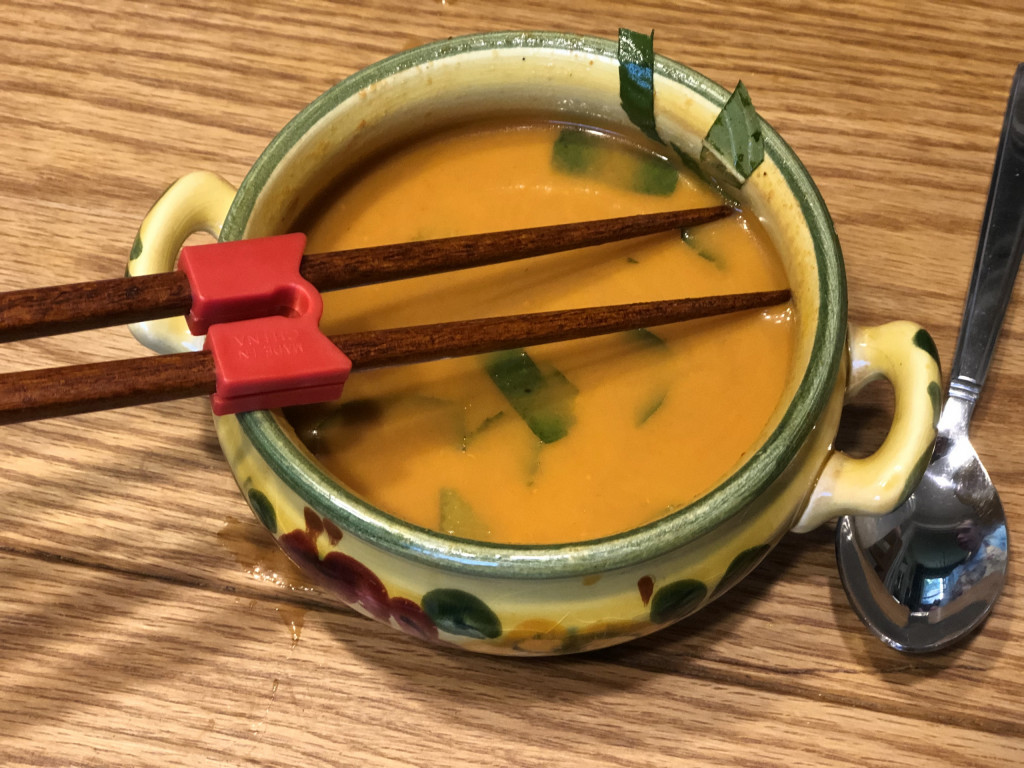
One of the things I love about this recipe, is the ability to customize your bowl with your favorite toppings. In my house, this type of approach is key to finding a dinner everyone loves. Robbie and I love adding thai basil from the garden, a swirl of sriracha, and chopped up pistachios for a little spicy crunch. The kids love fried tofu and rice noodles. The combinations and possibilities feel endless! If you experiment with toppings in your home and find a combo you love, please come back and share it in the comments!
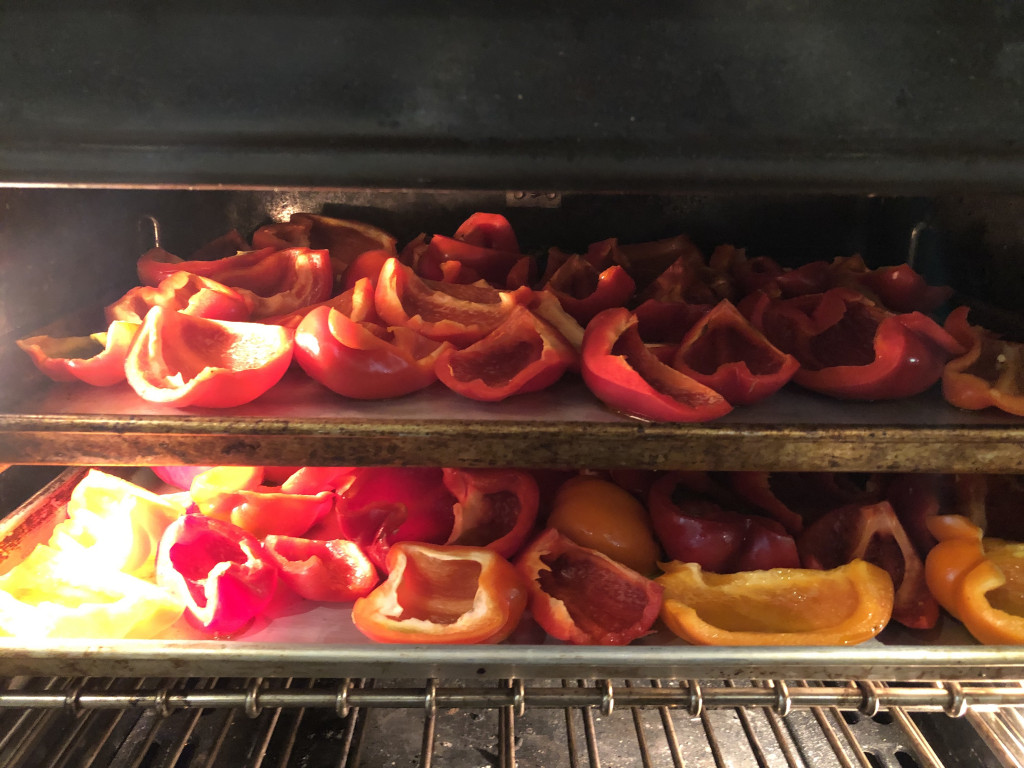

Home-roasted Red Peppers
My farmers market and nearby farm stands are overflowing with beautiful red, and even yellow and orange, peppers! Home-roasted red peppers might be the easiest and least time consuming way for you to dip your toe into the home food preservation waters. It’s a simple as 1, 2, 3!
- Wash and cut peppers into quarters, removing the stem, seeds, and inner white ribs
- Place on a baking sheet, drizzle with olive oil and roast at 450F until the skin starts to bubble and slightly blacken.
- Place into pint jars (each one will hold something like 3-5 peppers) and pop them into the freezer
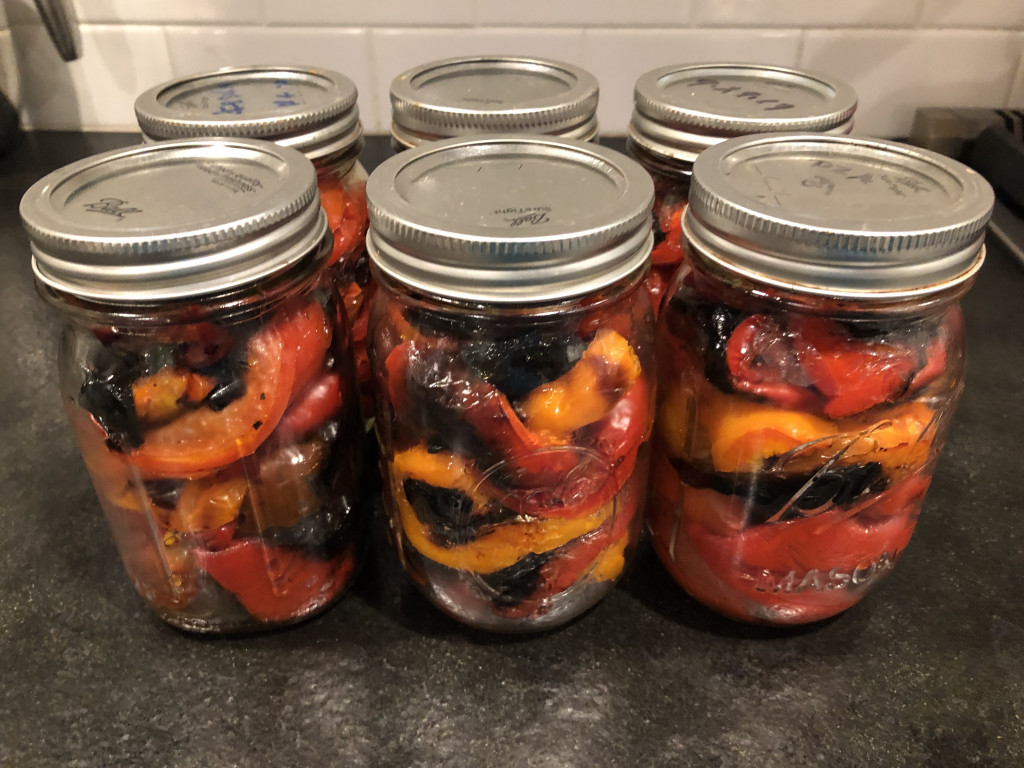
Roasted Red Pepper Curry Soup Recipe
(makes lunch/dinner for four to six people, leftovers are delicious too)
I have no idea where this recipe came from. I wish I could tell you the source, but I wrote it in my “favorite recipes book” and have been making it from there for the past couple of years. Apologies to the original author.
Download a printable PDF of this recipe here
Ingredients
- 2 teaspoons olive oil
- 2 cloves garlic, chopped roughly
- 1 inch ginger root, chopped roughly
- 3-4 red peppers, roasted in the oven as described above
- 1 quart (4 cups) vegetable or chicken stock
- 1 can coconut milk
- 3-4 Tablespoons red curry paste
- 2 Tablespoons soy sauce
- 2 Tablespoons lemon juice (lime would work just fine too)
Optional ingredients for topping (I recommend picking 3 or 4 of these)
- 1/4 cup cilantro, basil, or parsley, chopped
- 1 package of tofu, tossed in corn starch and pan fried in oil
- 1/2 package brown rice noodles (follow instructions on the package to cook)
- 1/2 cup peanuts, pistachios, or other favorite nuts, chopped
- Sriracha or other hot sauce
Instructions
- In a medium pot, saute garlic, ginger, and red peppers in olive oil on med-high heat until soft
- Add stock, coconut milk, curry paste, soy, and lemon juice. Bring to a boil
- Reduce heat to medium and cook for 5 minutes (longer is fine)
- Blend (I’ve used both an immersion blender and a countertop blender. Both work fine here)
- Optional: if you like a smoother soup, I recommend pouring it through a mesh sieve or strainer. If you don’t mind a chunky soup (or don’t have a sieve/strainer), you can skip this step.
- Salt and pepper to taste.
- Add your favorite toppings/stir ins from the options listed above or GET CREATIVE with what you have/love
- ENJOY!

Please share your comments, questions, and favorite toppings for this soup in the questions below! If you want to share gorgeous photos of your dinner, please tag me on Instagram and Facebook @carbonfreefamily. I LOVE seeing your beautiful photos!
]]>
There’s a joke in Michigan (at least in my circles) that you should never leave your car unlocked in the summer… not because someone will steal something out of it, rather because someone will put a pile of zucchini INTO your car and then you’ll be stuck with them! I’ve FINALLY found my zucchini recipe, so go right ahead and drop your extras on my front porch! Just the little one’s please… you can keep your “war clubs” for zucchini bread!
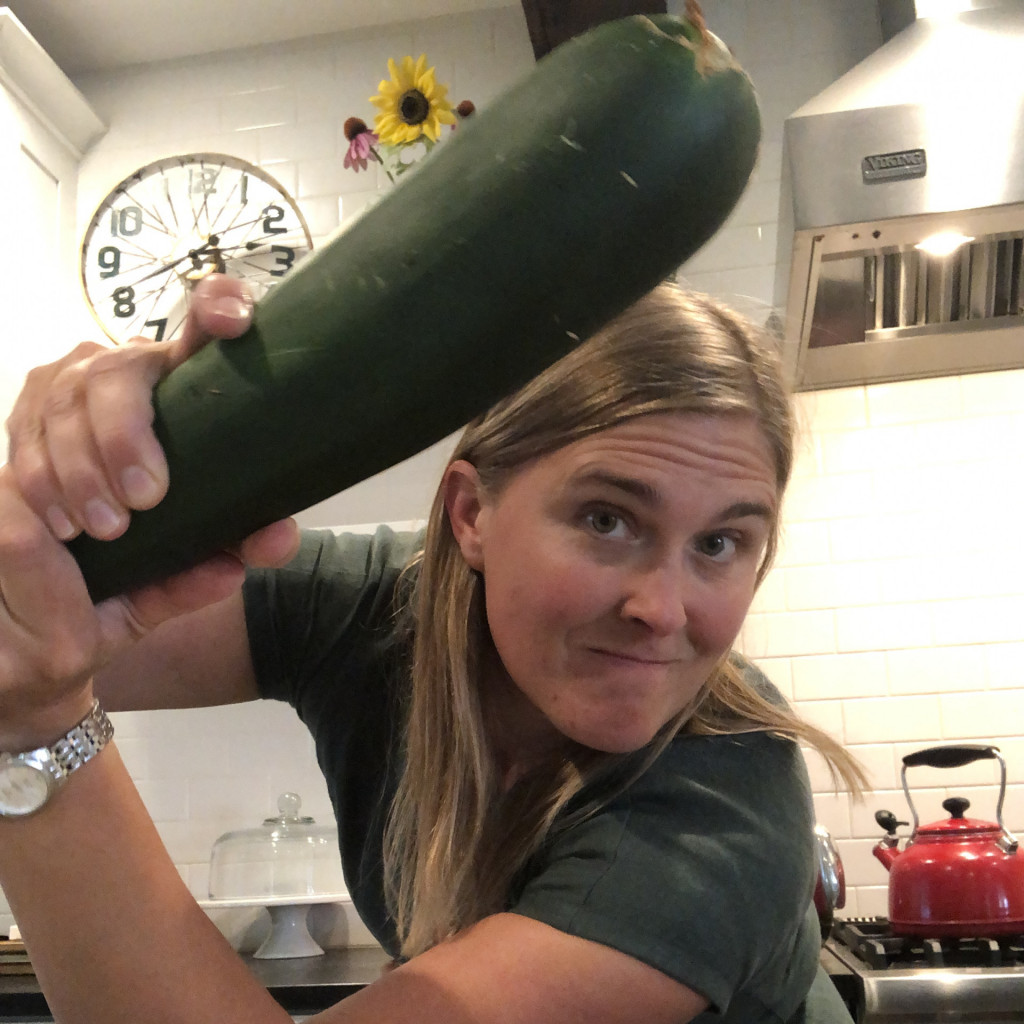
Given that I generally try to avoid both carbohydrates and sugar, I’m not a huge fan of zucchini bread and have been looking for a more healthy way to eat the abundance of zucchini that comes from my backyard vegetable garden each year. This zucchini carpaccio salad from Smitten Kitchen is just the ticket! Tho original recipe includes a bed of arugula, under the zucchini, which I bet would be delicious, but my arugula bolted months ago, so I’ve been making this salad with just zucchini and it’s still delish!
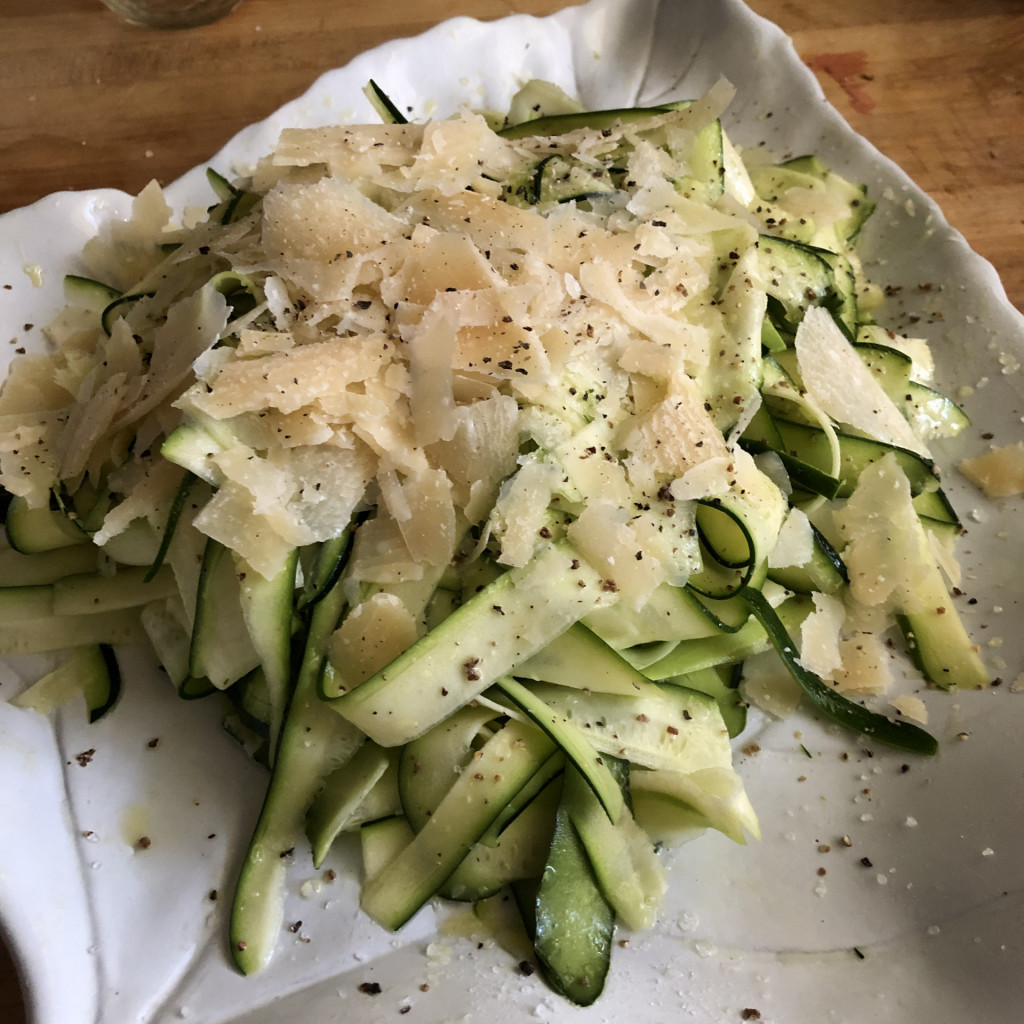
Recipe
(makes lunch/dinner salads for two or three people, more if you’re serving it as a side)
This recipe is adapted from Smitten Kitchen
Download a printable PDF of this recipe here
Ingredients
- 1 1/2 pound zucchini (about 3 small/medium)
- 1 ounce parmesan, coarsely grated or shaved with a vegetable peeler (about 1/2 cup)
- 3 Tablespoons olive oil
- Juice of one lemon
- freshly ground black pepper and salt, to taste
Instructions
- Use a vegetable peeler to create zucchini ribbons*
- Put zucchini in a large bowl. Drizzle with olive oil and lemon juice. Mix to combine (I usually do this with my hands to keep the zucchini ribbons from breaking).
- Sprinkle with parmesan and black pepper.
- ENJOY!
A couple of notes that you might find helpful….
*The original recipe tells you to toss zucchini ribbons with 1 teaspoon salt in a large colander set over a bowl and let drain 20 minutes. Rinse zucchini slices well, then drain, pressing gently on slices to extract any excess liquid. Pat zucchini slices dry with a kitchen towel. I regularly skip this step. Sometimes the salad is a little more liquid-y (technical term, I know) than others, so if you’re creating this dish for an occasion and want to make sure it’s not watery, this step might be useful to you.
*Also, Deb says that she often prepares the zucchini up to this point ahead of time. She says that once drained well, they keep in the fridge for a few days in a container so you can use them here or elsewhere. I haven’t tried this yet, but I have noticed that when I make my salad ahead of time it is more watery (see above), so I bet these steps in combination will solve for that.
Please tell me your favorite zucchini jokes, stories, and recipes! Are you on “team zucchini bread” or do you have another favorite recipe that I should try??
]]>
As a child and through my early twenties, I firmly believed that I did NOT like tomatoes. Now that I’m a little older, I’ve come to understand that the tomatoes you can buy in the grocery store in February are a pathetic shell of the locally grown (in my garden or by a local farmer) summer tomato.
These days, I avoid fresh tomatoes like the plague for 10 months of the year until the magical tomato season arrives, right on schedule at the beginning of every August (here in Michigan). In this moment (yes, right now!), I eat ALL THE TOMATOES!
My favorite recipes for fresh tomatoes
This means the Augustine house is eating fresh tomatoes for nearly every meal. Some of my favorite “recipes” aren’t really even recipes at all, but rather a collection of delicious ingredients set near each other on a plate. The key to each of these is REALLY GOOD ingredients. If you haven’t already, now is a great time to seek out the best olive oil and balsamic vinegar you can find. My local favorite is a Spanish olive oil, called Arbiquina, that I can buy in bulk from a local shop called Old World Olive Company (Michigan friends, they have several locations around the state). My absolute favorite balsamic is from a farm in Texas, but we haven’t been able to get it in recent years, so I’m currently using an 18-year traditional balsamic, also from Old World Olive Company. I buy my burrata and fresh mozzarella (and pretty much every other cheese I eat) from my local cheese shop, the Rockford Cheese Shop.
My favorite “new” recipe is this gorgeous five ingredient tomato and burrata salad from Barefoot Contessa. After eating this salad almost every day in the past week (psst… it’s really delicious for breakfast!), my favorite combination is: tomatoes, burrata, olive oil, salt and pepper. Add basil (like in the photo below of the first time I made this yumminess, last weekend) or balsamic (like in the recipe linked above) if you feel like it. Or not. It’s completely up to you!

And the gateway Caprese salad (for many of us, including me, this is the first way people begin their love affair with tomatoes). Again, this “recipe” includes just a few fresh and simple ingredients… tomatoes, fresh mozzarella, and basil stacked in beautiful little piles, topped with balsamic vinegar, olive oil, salt, and pepper.

My favorite recipes to preserve tomatoes
I don’t know about you, but I can only eat so many tomatoes (just me? hmmm. Must be the 26 tomato plants we planted this year in our backyard veggie garden, but we can’t keep up!). Each year, in August and September, we spend countless hours in the kitchen preserving tomatoes so we can eat this delicious local food all year long.
Last year, I created a series of blogs focused on preserving food and collected them all into this free course. The course includes individual lessons that explain the basic preservation methods of canning, freezing, and dehydrating, and specific examples of how I use these preserving methods in combination to preserve tomatoes, corn and all my favorite foods so I can eat them all year long.
Whenever you’re ready, these recipes are here waiting for you. My favorite ways to preserve tomatoes include (follow the links below for more information and recipes):
- Freeze them whole (it’s just as simple as it sounds… I put whole tomatoes (no processing) into a ziploc bag and throw them straight into the freezer. These are good for soups and sauces throughout the year, but not slicing because the freezing breaks down the cellular structure, which is a fancy way of saying they’ll be mushy when you defrost them)
- Can them as diced, quartered, halved or whole
- Grandma’s tomato sauce (I can it, but you could just as easily freeze it)
- Sun dried tomatoes (perfect for freezing)
- Tomato paste (perfect for freezing)

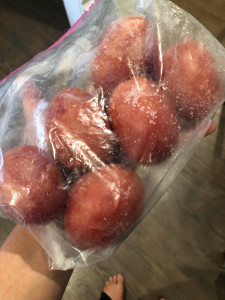
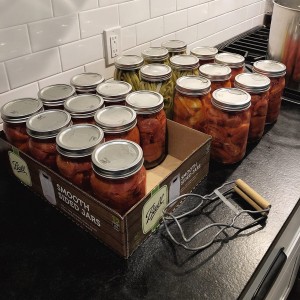
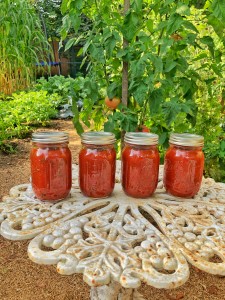
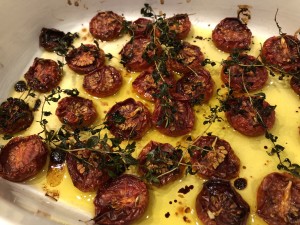

All of these recipes are delicious, but I have to tell you that homemade tomato paste changed my life! If you’ve never made your own I have to insist that you put it on your weekend “to do” list right now. This year. Before buying another single can of tomato paste. It’s truly that good. I can honestly say that I hope I never have to use the commercially made paste again.
Please share your thoughts, questions, and favorite recipes in the comments! How do you like to eat fresh tomatoes? How do you preserve them for later?
]]>
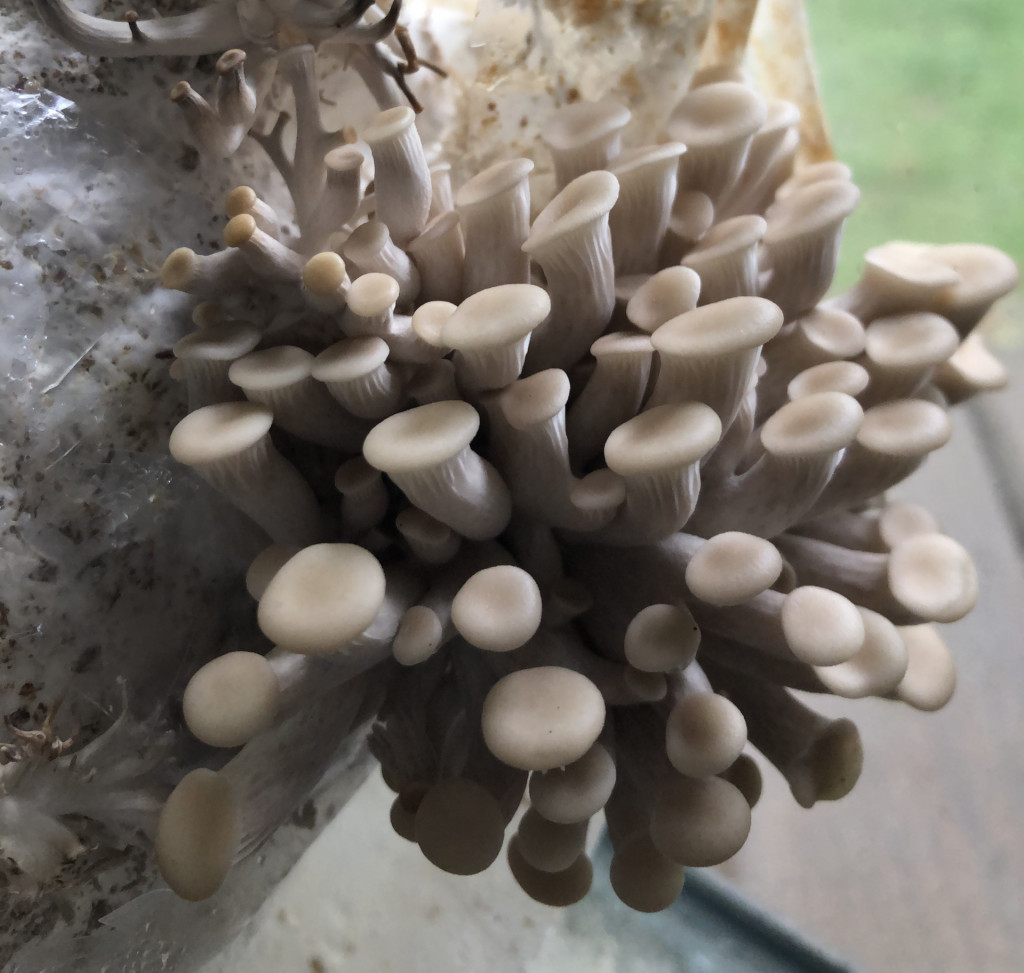
I struggled for a few minutes with the fact that the kits come in plastic bags, but like everything else, I’m embracing a #progressnotperfection attitude and looking for ways to eliminate the plastic bag in the future.
I’m growing oyster mushrooms using a grow kit from Mycophile’s Garden. They’re a mushroom farm located in Southwest Michigan and such a gift! I bought my first kit through West Michigan Farm Link (an awesome source for local food that I discovered this winter as I was trying to buy from more local farmers, even during the Michigan winter), but now they’re at my farmers market (and in Kalamazoo, Fulton Street, Grand Haven, St. Joe and others all over southwest Michigan), so I can easily restock. They also sell mushrooms by the pound, so you can pick some up tomorrow morning and make this salad for lunch!
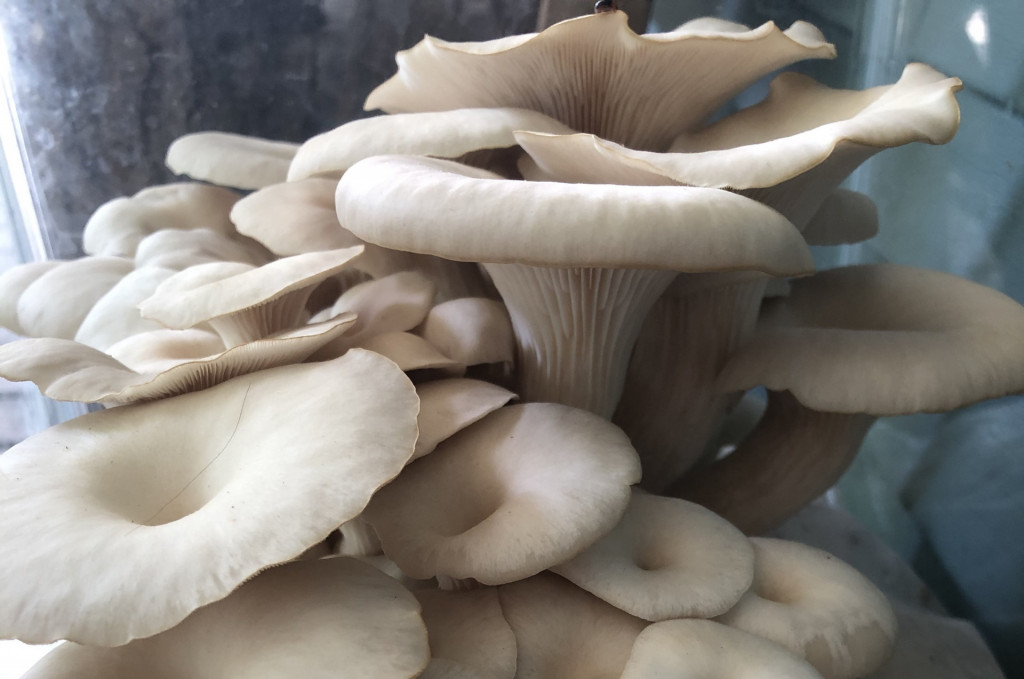
I paid $20 for my oyster mushroom kit and have already harvested 3 pounds of mushrooms! And mine is currently fruiting for the third time right now. It’s the little things like this that bring me so much joy! The kit comes with growing instructions and I’m shocked at how easy it has been to grow these beautiful and delicious oyster mushrooms.

I’m trying to branch out and find new recipes (so please send me your favorites in the comments or by email carbonfreefamily@gmail.com), but it’s hard to try new things when this warm mushroom salad is SO. DAMN. DELICIOUS! I made a disappointing mushroom pizza (with the homegrown oyster mushrooms) a couple of weeks ago and Robbie summed it up well when he said, “I mean this pizza is pretty good, but I’m comparing it to that amazing salad and I want the salad instead.”
I usually make the salad with oyster mushrooms and they’re still my favorite by far, but I’ve tried it with shiitakes and lions mane too and it was pretty good too. If you try it with other varietals, please come back and tell me about it!
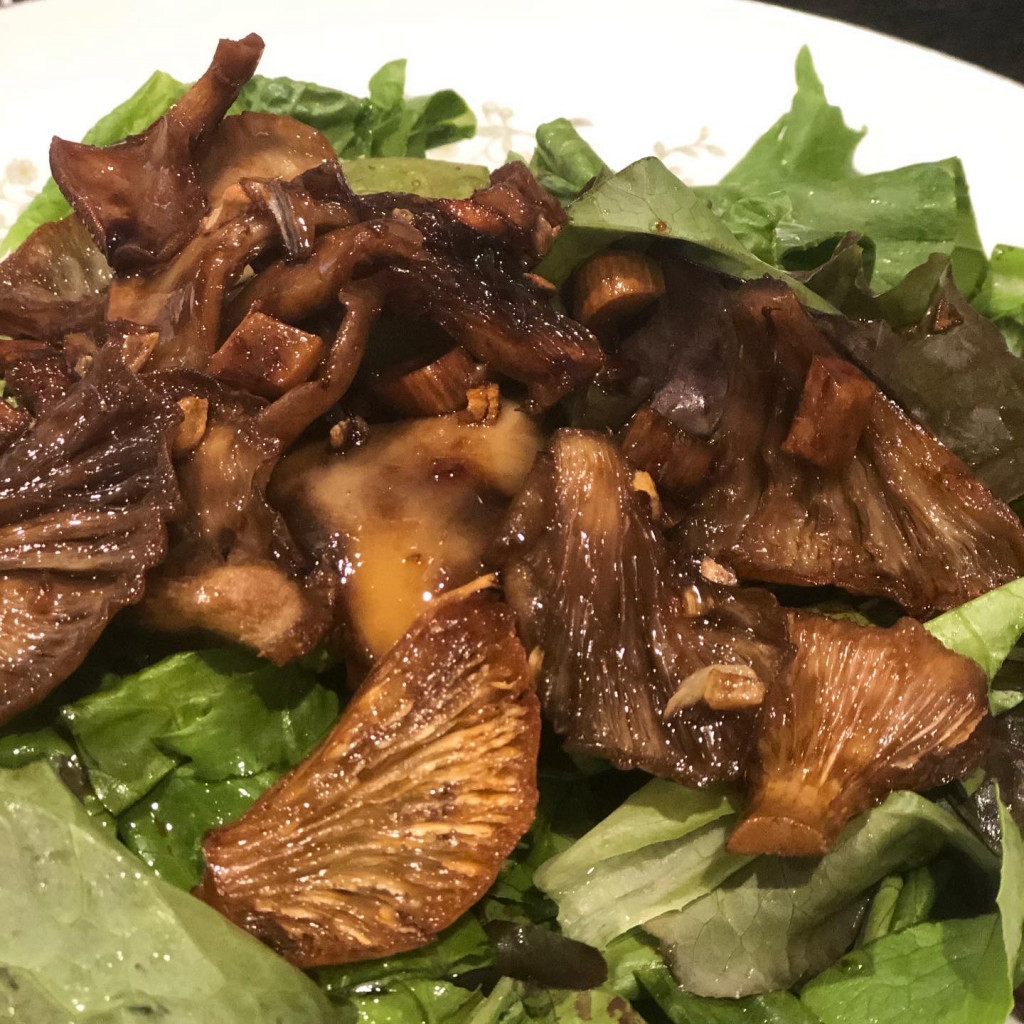
Recipe
(makes lunch/dinner salads for two or three people, more if you’re serving it as a side)
This recipe is adapted from Jamie Geller
Download a printable PDF of this recipe here
Ingredients
- 2 Tablespoons olive oil
- 1/2 to 1 pound mushrooms, cleaned and torn into pieces
- 2 garlic cloves, minced
- ¼ cup balsamic vinegar
- 3 cups salad greens (arugula works really nicely)
- salt + pepper
Instructions
- Clean your mushrooms. If they’re wild foraged and dirty, I recommend cleaning them as best you can without water, using a pastry brush, blowing the dirt off with your breath, or dusting it off with your fingers. Water changes the texture of mushrooms in a way thats unpleasant to me
- Tear them into large pieces. I read somewhere that the jagged edge makes them crisp up nicely and I’ve come to love the texture of torn mushrooms. If you have stems, chop them into small pieces.
- Heat olive oil over medium heat in a large saute pan, add mushrooms and cook, stirring occasionally until mushrooms are deep golden brown and have crispy edges, about 10 minutes.
- Add garlic and stir for just another minute to soften garlic a bit. Add balsamic and stir to coat mushrooms.
- Divide lettuce between 2-3 plates, top with warm mushrooms and drizzle with pan juices.
- Serve immediately and enjoy!
I can’t wait for you to come back and tell me how your mushrooms are growing! And if you like this salad! And if you tried it with other kinds of mushrooms!
]]>

If you’re dreaming of fruit season and want to start thinking about buying and preserving more local food, I’ve created two free ebooks to help you with these goals: one to help you Eat More Local Food and a second to help you Preserve Local Food for Eating All Year Long
Last summer I froze so much fruit… this much to be more precise:
- 120 pounds of tart cherries
- 50 pounds of blueberries
- 30 pounds of strawberries

Now that it’s the middle of winter and I’ve realized that I’m still not very good at eating local food during the winter months (you can read more about this realization and subsequent goal to do better in this recent blog post), I’m pivoting my focus to creatively using all of this delicious frozen fruit.
Now, my kids absolutely love frozen tart cherries. It’s the preferred snack in our house… a simple bowl of frozen cherries. There’s something about the tartness and frozen sugars that melt in your mouth in the most magical way. If you’re never tried eating a frozen tart cherry, I highly recommend it.

Another favorite food around here is something called a dutch baby. It’s like a pancake, but with a whole lot less flour and a whole lot more eggs, which makes it practically a health food in my book. We first discovered dutch babies in… you guessed it, the Netherlands… specifically in December 2017, at a rustic restaurant that was connected to a gorgeous little outdoor ice skating rink in the middle of Amsterdam. Here we had a savory version with bacon. It wasn’t until we got home and I started obsessively looking for recipes that I realized most Americans make them with fruit and powdered sugar.
For several years, my go to topping was fresh red raspberries (which is pretty much my favorite food ever… you should have seen the massive quantities of raspberries I ate during my first pregnancy), but as my commitment to waste free principles grew over the past couple of years, so did my disappointment with the fact that I can only buy fresh berries at my local grocery stores in single use plastic clamshells. In the summer, I will happily return to fresh red raspberries (picked in my backyard or purchased from the farmers market) on top of my dutch baby, but I’ve begun experimenting with alternative fruit toppings that will reduce my waste. And let me tell you that our new favorite topping is tart cherries!

Recipe
(makes one large or two small, enough for two people; we double this for our family of four)
This recipe is adapted from Orangette
Download a printable PDF of this recipe here
Ingredients
6 Tbs unsalted butter
4 large eggs
½ cup whole wheat flour
½ cup half-and-half
4 cups frozen tart cherries (or other fruit of your choice)
Extra butter for melting on top
Juice of 1 lemon
Powdered sugar
Instructions
- Preheat the oven to 425 degrees Fahrenheit
- Divide the 6 tablespoons butter between two 6-inch cast-iron skillets (or one larger skillet; mine is 10 inches and works great) and melt it in the oven while it preheats
- In a blender or food processor, whir together the eggs, flour, and half-and-half
- Once butter has melted, use a brush (or tilt the pan) to coat the sides of the pan with butter
- Pour the batter into the skillets over the melted butter. Slide the skillets into the oven, and bake for 25 minutes
- While the pancake is cooking, place the frozen tart cherries into a small pot and cook over medium heat. You want them to fully defrost and start to simmer, but don’t cook away all of the liquid
- Remove the puffed pancakes from the oven, transfer them to a plate or shallow bowl, top with additional butter (if desired), tart cherries, lemon juice, and dust with powdered sugar
- Serve immediately and enjoy!

Don’t worry if yours don’t rise as much as some of these photos. Especially when I use whole wheat flour, sometimes the rise isn’t as impressive (like in the photo immediately above), but I can assure you they still taste delicious. If the rise and presentation is important to you, try using white flour and/or substituting whole milk for some of the half and half.


How might you modify your favorite recipes to include seasonal, local food? Please share your ideas, tried and tested recipes, and challenges in the comments.
]]>
My annual goal setting, much like my life, is a slow and reflective process. I like to calculate my environmental footprint (see my blog post last week for more information), reflect on last years’ progress and this year’s biggest opportunities.
I’m excited to take you on a journey of my 2021 intentions. I’ve organized them to coincide with the areas highlighted by the environmental footprint calculator and in order of my biggest to smallest opportunity to reduce my impacts: transportation, food, shelter, goods, and services.

Transportation remains my biggest opportunity. So, this year, I have the following goals:
- No flights – In 2020, we committed to no flights and found adventure nearby (see last week’s blog for more details). We explored our home state of Michigan and had wonderful family adventure (yes, even in the midst of the pandemic). I love travel, but I know how impactful my flights are. In 2021, we’re going to remain focused on nearby adventures, expanding our radius to include longer car rides this year… we’ve got a date with the smoky mountains for spring break! My long term solution will include offsetting the emissions from our family vacations, so please send me your recommendations if you’ve purchased offsets.
- Become a one car family again – In 2020, we bought a 100% electric vehicle (again, see last week’s blog for more details). We’ve been a one car family for several years, but it’s taken us months to fully embrace our new Tesla and be ready to give up our trusty old ‘08 Honda Fit. This is mostly because Robbie has dirty hobbies like hunting and woodworking and we had to figure out a way to haul messy things in our “fancy new car”. A few weeks ago, we installed a trailer hitch on the Tessy, so we’re finally ready to let Honda go and return to being a one car family. I can’t tell you how excited I am to never buy gasoline again!
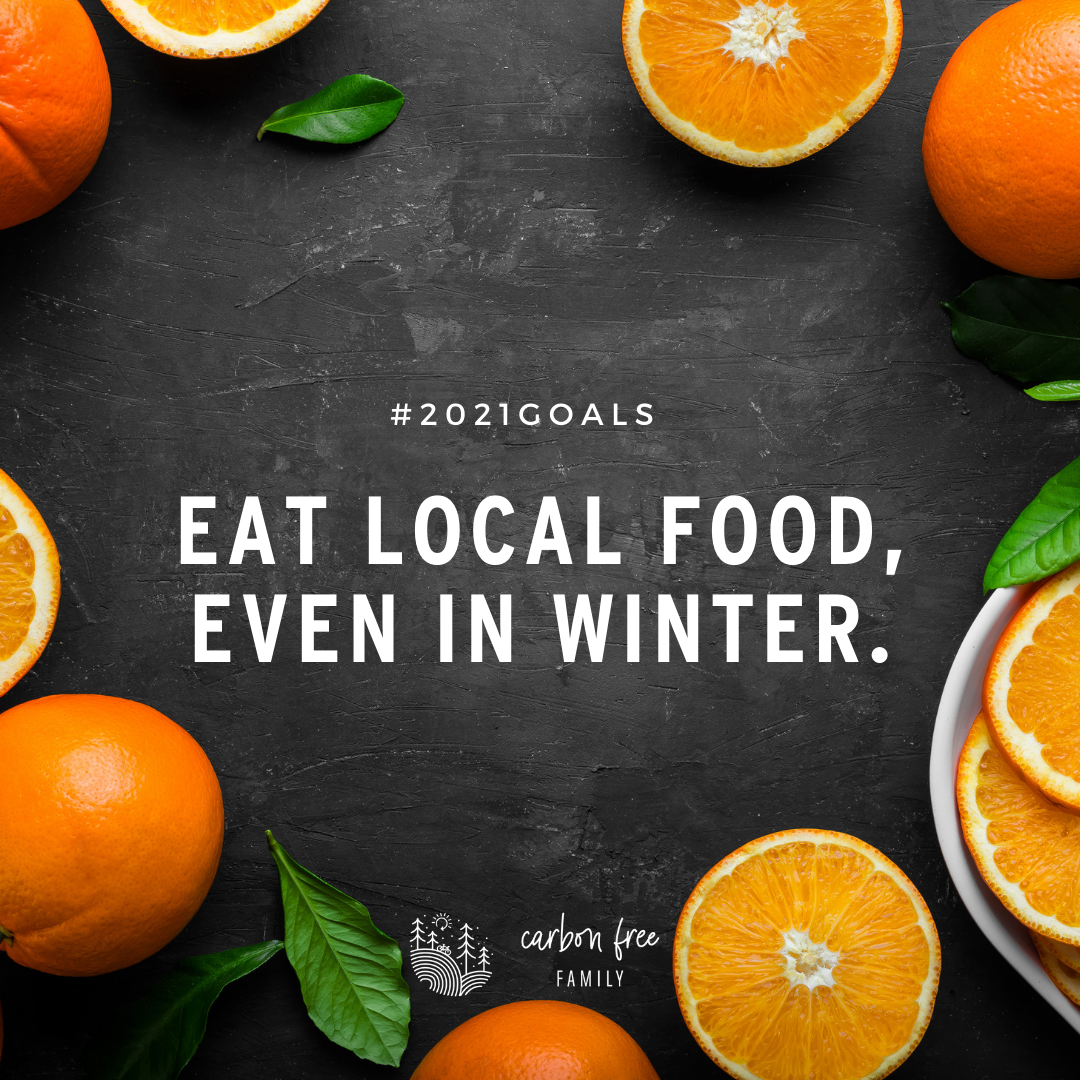
My food is wildly important to me as I work to fully align my life with my values. And it’s my second biggest opportunity to impact my footprint. I also find the food category to be a stubborn one… meaning, its hard to see the impact (via a lower environmental footprint in the calculator) from the changes I’ve made (one more time, see last week’s blog for more on this). But that’s not going to stop me from leaning in to the joyous parts of my food journey! This year, I have only one food-related goal:
Eat local food, even in winter.
I’m proud of my summertime foodprint (that is, the environmental footprint of my food), but during the winter in Michigan I struggle to find locally grown, unpackaged food. So, I’m going to focus on this goal especially hard in the next couple of months (February through May) until my own backyard vegetable starts to produce and my local farmers market starts up again.
Here’s where YOU can help!
Michigan friends – please comment below with your favorite winter farm shares, farmers markets, and other resources you have for local food (that are available right now!) so I can build a robust list of farmers to support during these cold winter months. I promise to explore your recommendations and share my adventure, with details and recommendations, in an upcoming blog post.
Non-Michigan friends – please share your strategies and recommendations too! I have followers all over the world and we can always learn from your strategies!
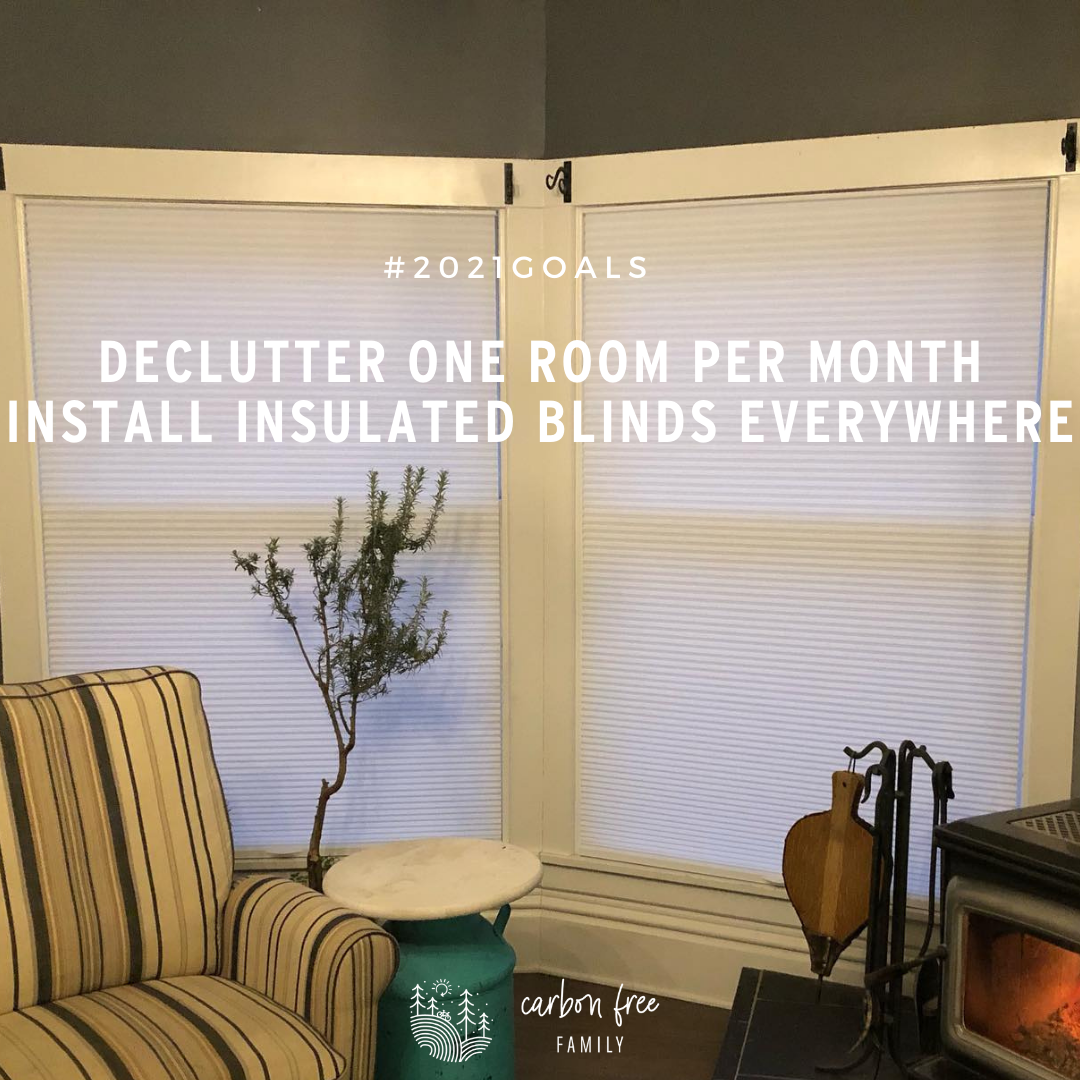
This year I’ve realized how very important it is for my home to be a place of peace, relaxation, and comfort. A place that calms my nerves, supports connected time with my family, and gives my soul space to Just Be Here. It’s not surprising that my 2021 goals include a few to make my home more cozy (and energy efficient) and less cluttered. I love it when the connections between minimalism and sustainability are clear like this.
- Declutter one room per month. Less stuff means less cleaning, less things to break, less things to repair, and more time with my family.
- Install insulated blinds everywhere. Cozy spaces in my home encourage all of us to slow down, sit down, play together and take the time for meaningful connection. Last year, we installed these blinds in most of the windows on the first floor of our home. Even I was shocked at how much warmer I felt in these better insulated spaces. And even better, we could see on our nest thermostat that the furnace was running less often, saving energy, carbon emissions and our hard earned money!
Alright! We’re halfway through my 2021 intentions and this feels like a good spot to take a break. I’ll be back next week with my goad related to goods, services, and self care (self care isn’t part of the footprint calculator, but I’ve added it. I firmly believe that we have to take care of ourselves before we can take care of the community and the planet).
Intentional living takes time. Sometimes the process is (intentionally) slow. If you’re still thinking about 2021 and what you might want to work on, I’m right here with you and for you. Drop your thoughts and questions in the comments. I’d love to hear about your goals, even if they’re still a “work in progress”.
]]>
